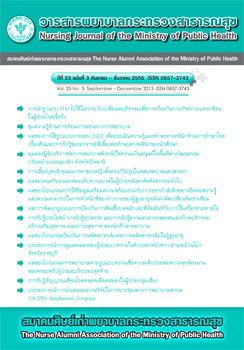ผลการพัฒนารูปแบบการป้องกันการติดเชื้อปอดอักเสบ ที่สัมพันธ์กับการใช้เครื่องช่วยหายใจ
Main Article Content
Abstract
การวิจัยนี้เป็นการวิจัยเชิงปฏิบัติการ เพื่อศึกษาผลการพัฒนารูปแบบการป้องกันการติดเชื้อปอดอักเสบที่ สัมพันธ์กับการใช้เครื่องช่วยหายใจ กลุ่มตัวอย่างคือผู้ป่วยที่ใช้เครื่องช่วยหายใจในหอผู้ป่วยหนักและหอผู้ป่วย สามัญจำนวน 442 คน และพยาบาลที่ดูแลผู้ป่วยที่ใช้เครื่องช่วยหายใจจำนวน 159คน เครื่องมือในการวิจัย แบ่งเป็น 2 ส่วน ได้แก่เครื่องมือในการทดลอง คือ รูปแบบการป้องกันการติดเชื้อปอดอักเสบที่สัมพันธ์กับการใช้ เครื่องช่วยหายใจซึ่งถูกพัฒนาตามกระบวนการวิจัยเชิงปฏิบัติการที่ผู้วิจัยและทีมผู้ปฏิบัติร่วมกันพัฒนาขึ้นแบ่งเป็น 3 ระยะ คือระยะที่ 1 ทบทวนและพัฒนา แนวทางปฏิบัติเดิม ระยะที่ 2 ร่วมสร้างนวัตกรรมสู่มาตรฐานการปฏิบัติ ระยะที่ 3 การนำนวัตกรรมไปใช้และใช้กระบวนการทางวิจัยในการประเมินประสิทธิผลเพื่อนำไปสู่การพัฒนาที่ ต่อเนื่อง เครื่องมือในการรวบรวมข้อมูล คือ แบบประเมินการติดเชื้อปอดอักเสบของศูนย์ควบคุมการติดเชื้อ โรงพยาบาลสระบุรี แบบสอบถามความคิดเห็นของพยาบาล และแบบสัมภาษณ์ในการสนทนากลุ่มย่อยที่ผู้วิจัย สร้างขึ้น การวิเคราะห์ข้อมูลใช้สถิติเชิงพรรณนา และการวิเคราะห์เนื้อหา ผลการวิจัยสรุปได้ ดังนี้
1. อุบัติการณ์การติดเชื้อปอดอักเสบที่สัมพันธ์กับการใช้เครื่องช่วยหายใจ ภายหลังการพัฒนารูปแบบ การป้องกันการติดเชื้อปอดอักเสบที่สัมพันธ์กับการใช้เครื่องช่วยหายใจยังมีอัตราสูงขึ้นเป็น 14.58 ครั้ง/1,000 วัน ใช้เครื่องช่วยหายใจ
2. พยาบาลทุกคนมีความพึงพอใจต่อรูปแบบการพัฒนาการป้องกันการติดเชื้อปอดอักเสบที่สัมพันธ์กับ การใช้เครื่องช่วยหายใจ และต้องการให้มีการดำเนินการต่อเนื่อง
ข้อเสนอแนะ ควรนำรูปแบบการพัฒนาแบบมีส่วนร่วมในการป้องกันการติดเชื้อปอดอักเสบที่สัมพันธ์ กับการใช้เครื่องช่วยหายใจไปใช้ในกลุ่มอื่นเพื่อยืนยันผลลัพธ์
Development of Ventilator Associated Pneumonia Preventive Model
Pakavadee Boonyachart*
Junkum Pho-ong**
Abstract
This action research aimed to develop an Associated Pneumonia Preventive Model and assess its effectiveness. The sample consisted of 442 patients using a mechanical ventilator and 159 nurses in an ICU and general wards. The experimental instrument was the Ventilator Associated Pneumonia Preventive Model developed by the researchers and participants. The study was divided into 3 phases. Phase 1 involved a review of traditional practice and development. Phase 2 included a synthesis and development of an innovative model for standard practice. Phase 3 consisted of implementation of the developed model and assess its effectiveness in order to get information for continuous development. Instruments employed for data collection were Ventilator Associated Pneumonia (VAP) screening, questionnaire, and guideline for small group interview. Descriptive statistics and content analysis were used to analyze the data.
The results revealed that the incidence of Ventilator Associated Pneumonia continues to increase as high as 14.58 time/1,000 days of ventilator used. All nurses were satisfied with the model and had a desire to continue the Participatory Development Model. From the results it can be suggested that nurses can apply the participatory developing model in other settings and confirm the effectiveness of the model.
* Registered Nurse, Senior Professional Level, Saraburi Hospital
** Registered Nurse, Professional Level, Saraburi Hospital
Article Details
บทความและรายงานวิจัยในวารสารพยาบาลกระทรวงสาธารณสุข เป็นความคิดเห็นของ ผู้เขียน มิใช่ของคณะผู้จัดทำ และมิใช่ความรับผิดชอบของสมาคมศิษย์เก่าพยาบาลกระทรวงสาธารณสุข ซึ่งสามารถนำไปอ้างอิงได้
